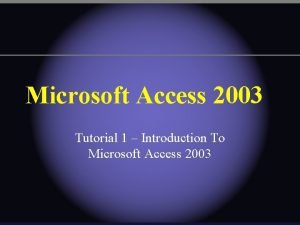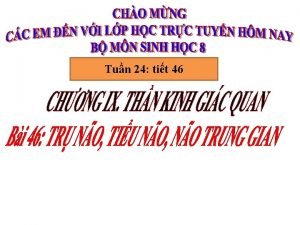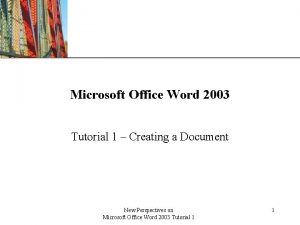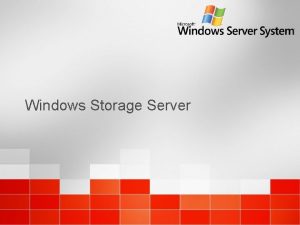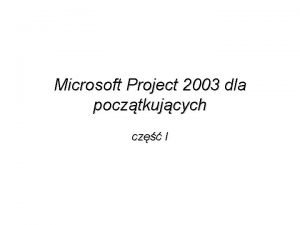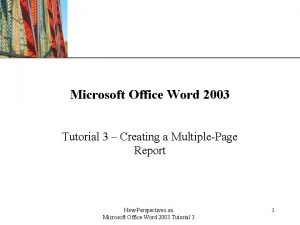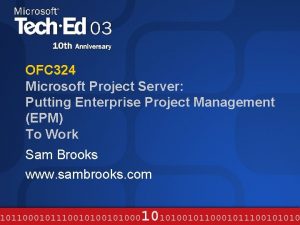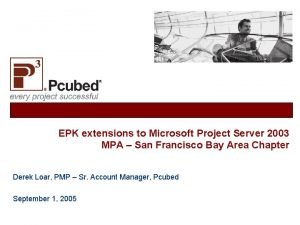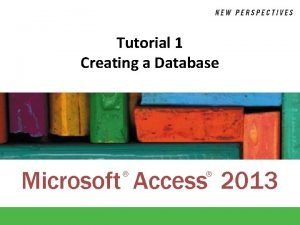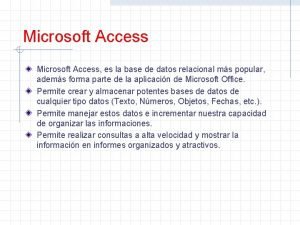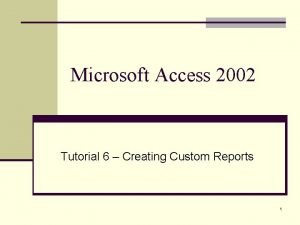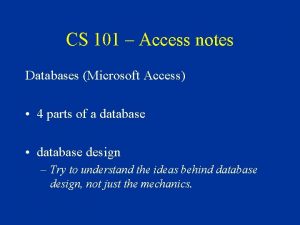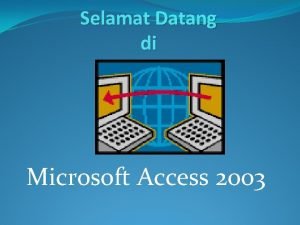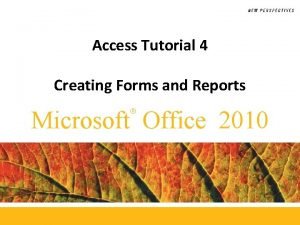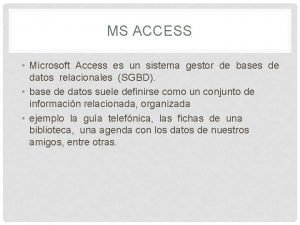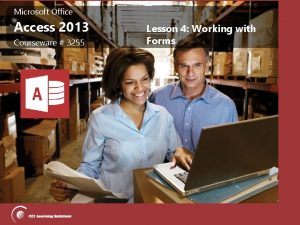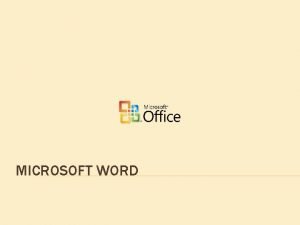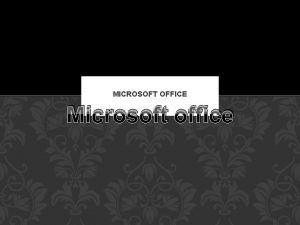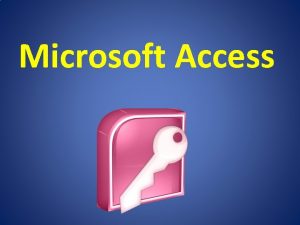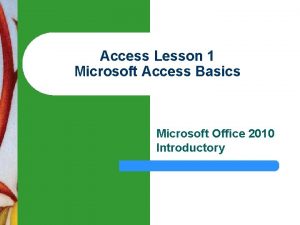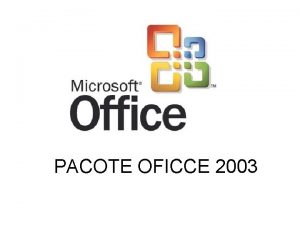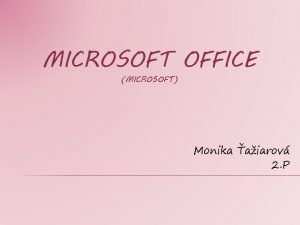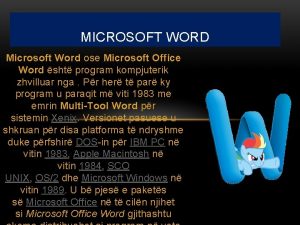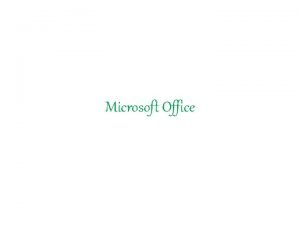Microsoft Office Access 2003 S tit 30 tit

























- Slides: 25

Microsoft Office Access 2003 Số tiết: 30 tiết lý thuyết 60 tiết thực hành Giáo viên: Từ thị Xuân Hiền

CHAPTER 1 FUNDAMENTALS

• Microsoft Access is a powerful database program, you can use to store all kinds of information. • Once information is stored in a Microsoft Access database, it's easy to find, analyze, and print. • This chapter is your introduction to Microsoft Access and the world of databases.

1. Introduction to Databases • A database is a collection of information that is organized into a list and stored in a manner similar to a file cabinet. • A database program lets you: § Store Information. § Find Information. § Analyze and Print Information. § Manage and Share Information.

1. Introduction to Databases • A Microsoft Access database may contain up to seven different database object types: § Tables: store a database's data in rows (records) and columns (fields). § Queries: ask a question of data stored in a table. § Forms: custom screens that provide an easy way to enter and view data in a table or query.

1. Introduction to Databases § Reports: present data from a table or query in a printed format. § Pages: designed for viewing and working with Microsoft Access data from an intranet or over the Internet. § Macros: help you perform routine tasks by automating them into a single command. § Modules: let you create libraries of functions that you can use throughout your application by using language Visual Basic.

1. Introduction to Databases • Starting Access : – Click the windows start button. – Select all programs microsoft office 2003 microsoft office access 2003. • Opening a Database: – Click the open button on the toolbar, or – Select file open from the menu, or Press ctrl + o.

2. Understanding the Access Program Screen • The Microsoft Access screen

2. Understanding the Access Program Screen • Title bar • Menu bar • Toolbar • Database window • Objects bar • Database objects • Status bar

3. Tour of a Table • The structure of a table

3. Tour of a Table • To open a table: § Click the tables icon in the objects bar and double-click the table or select the table and click open. • To move to the next record: § Click the next record navigation button, or press the key, or click the record you want to select.

3. Tour of a Table • To move to the previous record: § Click the previous record navigation button, or press the up arrow key, or click the record you want to select. • To move to the last record in a table: § Click the last record navigation button or press ctrl + end (when not editing record). • To move to the first record in a table: § Click the first record navigation button or press ctrl + home (when not editing record).

4. Adding, Editing, and Deleting Records • To add a new record: § Click the new record navigation button. Or § Click the new record button on the toolbar. § Enter the record information for the field, pressing tab to move to the next field and shift + tab to move to the previous field.

4. Adding, Editing, and Deleting Records • To edit a record: § Click the field you want to edit and make the changes. • To delete a record: § Place the insertion point anywhere in the record and click the delete record button on the toolbar.

5. Tour of a Form

5. Tour of a Form • Form which is used for adding, viewing, and modifying information in a database should be straightforward and easy. • Forms can also contain buttons that allow you to perform other actions, such as running macros to print reports or labels. • Forms can validate data • To open a form: – Click the forms icon in the objects bar and double-click the form or select the form and click open.

5. Tour of a Form • To move between records: – Use the record navigation buttons near the bottom of the screen. • To delete a record: – Place the insertion point anywhere in the record and click the delete record button on the toolbar. • To add a new record: – Click the new record navigation button

6. Tour of a Query • Example: The USA Employees query in Design view

6. Tour of a Query • Queries ask a question of the information in a table and then retrieve and display the results. • To open a query: – Click the queries icon in the objects bar and double-click the query or select the query and click open. • To display a query in design view: – Open the query and click the view button on the toolbar or Click the queries icon in the objects bar, select the query, and click design.

7. Tour of a Report • With a report, you can print database information from tables and queries • Reports are the most static of all the database objects. • Unlike tables and forms, which allow user interaction, reports just sit there, waiting to be printed.

7. Tour of a Report • To open a report: – Click the reports icon in the objects bar and double-click the query or select the query and click open. • To zoom in print preview: – Click the area you want to zoom (either in or out) with the magnifying glass pointer. • To print a report: – Click the print button on the toolbar, or select file print from the menu, or press ctrl + p.

8. Previewing and Printing a Database Object • The Print Preview toolbar • The Print dialog box

8. Previewing and Printing a Database Object • To print preview: – Click the print preview button on the toolbar. or select file print preview from the menu. • To print: – Click the print button on the toolbar, or select file print from the menu, or Press ctrl + p.

8. Using the Zoom Box • In its current state, the Notes field is not wide enough to display its contents.

8. Using the Zoom Box • Press Shift + F 2 to display the box, making the contents of any cell easier to view and edit.
 Access 2003 tutorial
Access 2003 tutorial Chất xám trong não
Chất xám trong não Tun tit tun tit
Tun tit tun tit 1 tit
1 tit Tun tit tunt tit
Tun tit tunt tit Aulaclic word 2003
Aulaclic word 2003 Tutorial word 2003
Tutorial word 2003 Windows storage server 2003
Windows storage server 2003 Ms project 2003
Ms project 2003 Microsoft word 2003 tutorial
Microsoft word 2003 tutorial Microsoft project 2003 demo
Microsoft project 2003 demo Mpa timesheet
Mpa timesheet Terminal access controller access-control system
Terminal access controller access-control system Terminal access controller access-control system
Terminal access controller access-control system Microsoft access 2013 tutorial
Microsoft access 2013 tutorial Base de datos relacional access
Base de datos relacional access Ms access 2002
Ms access 2002 Disadvantages of lims
Disadvantages of lims Ms access 101
Ms access 101 Paw privileged access workstation
Paw privileged access workstation Microsoft access 2013
Microsoft access 2013 Microsoft access database management system
Microsoft access database management system Kegunaan microsoft access
Kegunaan microsoft access Access forms tutorial
Access forms tutorial Microsoft access es un sistema gestor de base de datos
Microsoft access es un sistema gestor de base de datos Microsoft access para que sirve
Microsoft access para que sirve
